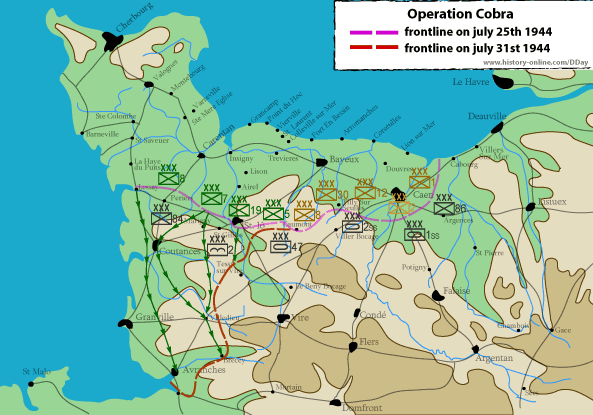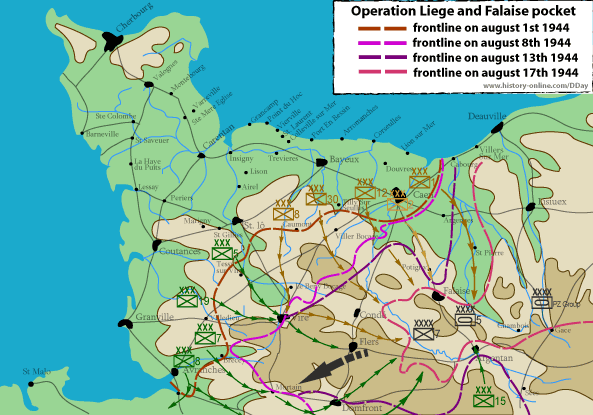Operation Cobra
Operation Cobra
At the end of July the Cotentin Peninsula was occupied by the 1st Army US commanded by General Bradley and the port of Cherbourg, despite the damages endured, was a very important objective reached by the Allies.
The conquest of Caen had been extremely costly in terms of loss of human lives and means (a good part of the armored means had been lost) and of time. The two months spent by the British and Canadian Corps to reach the objective allowed the enemy to pour in reinforcements in that sector and to make the conquest of the city and its outskirts still more difficult.
If there was a positive element of this situation, it was that the tenacity demonstrated at Caen had reinforced even more the German command’s conviction that this was for the Allies the most important sector of the entire theater. Consequently, the major part of German forces, especially the armored divisions, was concentrated here to contain the Allied advance. In the sector further east under American responsibility, the Germans assigned minor reinforcements, despite that here had been verified the deepest advancement in the preceding weeks.
Operation “Cobra” wanted to make the most of this situation. A rapid advance to the south, accompanied by significant air support, could break the German defenses and allow the enormous American forces (4 corps) to arrive on open terrain where they could profit from the maneuvering of armored and mechanized forces, leaving behind the trap of Normandy’s hedges and dykes. The intention was to reach Avranches, the gate to Brittany and Central France.
The geographical conditions favored this plan because it uses its own energy for the main advancement and for the protection of only the eastern flank, while the western one was protected naturally by the sea. This reduced by a lot the enemy’s possibility to go round and close the salient with a counterattack because the forces could only reach from one side and therefore, beyond being foreseeable, would meet major resistance. If, instead of aiming toward Avranches to the south, the directing line had been moved east, for example toward Vire, the Germans would have had a greater possibility of organizing an effective counterattack.

The VII Corps US guided by General Collins, who had conquered the Cotentin Peninsula and Cherbourg, was in charge of guiding the advance into the central sector, using the most pressure possible on the enemy front to break it and pour into the backlines.
The operation, fixed for July 24, was preceded by a vast carpet-bombardment over the German units stationed along the line of attack. Several American units on the frontline were hit mistakenly by the initial bombing, another demonstration of the difficulties in cooperation between the army and the air force when the use of strategic bombardiers was foreseen (similar to what happened at Omaha during D-Day), for which the operation was postponed for the following day.
Also on July 25 the bombardment caused deaths among the Allies and broke up the German units for 3 hours. The zone was bombarded so heavily that the debris and the craters slowed down the Allied advance. A passage was opened between Mantigny and St.Gilles through which the VII Corps penetrated ever more deeply.
Operation Liege
Operation Cobra had success and, while the VIII Corps US inundated Brittany with its armored columns, for the rest of the Allied forces it was necessary to reorganize and stabilize the front, consequently diminishing the impetus of the advance. The German army decided to profit from this moment of relative pause to organize a counterattack against the Americans, which was called Operation “Liege” and had the objective of joining the gap between Avranches and the coast. For this goal enormous armored forces were gathered, even from the sector of Caen, which had been calm for several weeks. The swan song of the German army in France was carried out August 7, when 5 armored divisions directed themselves toward Mortain.

The Allies managed to know in advance the German intentions thanks to intelligence and were able to prepare for the defense. During the night and the course of the day the disorganization of the German advance lost any residual advantage and the Allied tactical air force, composed of fighters and fighter-bombers, inflicted grave losses making the cohesion of the German operation even more difficult.
August 8 the II Corps CA launched Operation “Totalize” with the objective of Falaise, right in the sector from which the Germans had moved several units to create the maneuvering force of Operation “Liege.” Only the slowness and the disorder allowed the Germans to redirect the units that had still not reached the sector of activity and could oppose the advance of the Canadians. In the meantime in other sectors the Allied units moved to the counterattack profiting from the German stall.
A zone began to create itself called the"Falaise’s pocket" where 3 German armies risked remaining entrapped. Canadians and British pressed from the north while many corps US pressed the German troops from west to east, and the feared General Patton closed the sack, moving the XV Corps US from the south where, together with other corps of the III Army US, they had liberated the major part of Brittany. August 14 Argentan was in the hands of Patton’s units but up until August 20 a connection had not been established with the Canadian units and a part of the German units managed to flow through this narrow passage.
With these episodes the Battle of Normandy concluded. Despite the difficulties, the delays and the high losses, the Allies succeeded with an epic enterprise facing a powerful and determined enemy. The road to freedom was still long and lined with great sacrifices, but without this success nothing else would have been possible.